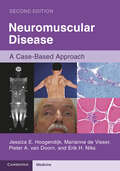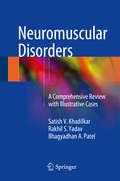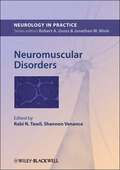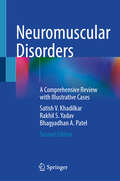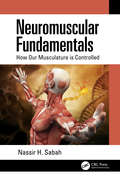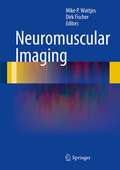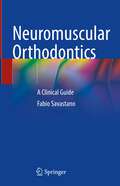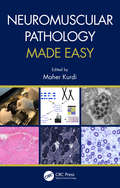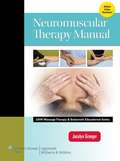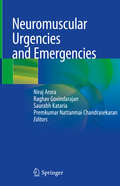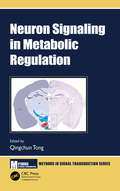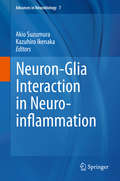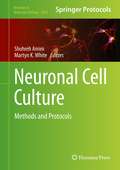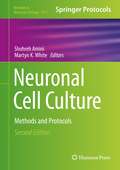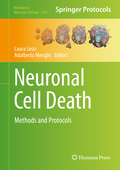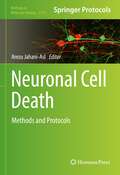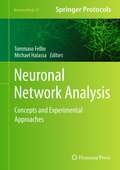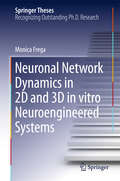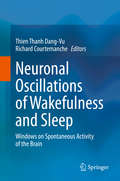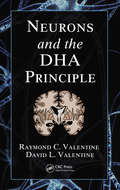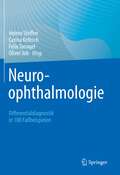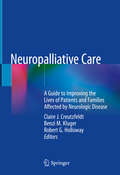- Table View
- List View
Neuromuscular Disease: A Case-Based Approach
by Jessica E. Hoogendijk Marianne de Visser Pieter A. van Doorn Erik H. NiksThere are over 800 neuromuscular disorders and this can leave clinicians feeling lost as they try to diagnose and manage patients. On the basis of 66 adult and paediatric neuromuscular case vignettes, readers will be walked through using case histories and clinical manifestations as a starting point for diagnosis. For each case, diagnostic tools, disease pathogenesis, prognosis and treatment options are discussed. Symptoms, signs and syndromes are cross-linked to help the reader navigate the array of disorders. Accompanying tables explain differential diagnoses and 30 videos demonstrate clinical features. This second edition has been thoroughly updated as the neuromuscular subspecialty has developed from clinically and pathologically descriptive to making use of new diagnostic technologies and therapies. Neurologists at all levels, paediatricians, internists, geneticists, rehabilitation physicians, physiotherapists and researchers in the field will find this an invaluable guide, as they seek to familiarise themselves with this complex range of disorders.
Neuromuscular Disease: A Case-Based Approach
by John H. J. Wokke Pieter A. van Doorn Jessica E. Hoogendijk Marianne de Visser John H. J. Wokke Pieter A. van Doorn Jessica E. Hoogendijk Marianne De VisserThere are over 600 neuromuscular disorders and the variability of these syndromes can leave clinicians feeling as if they are lost in a maze as they seek to diagnose and manage patients. This book addresses this problem by using the case-history and symptom manifestation as a starting point for the diagnostic process in adult patients, mimicking the situation in the consultation room. For each case, diagnostic tools, disease pathogenesis, prognosis and treatment options are discussed, along with rare manifestations and differential diagnoses. Symptoms, signs and syndromes are cross-linked to help the reader navigate the variety of disorders. Accompanying tables give a broader picture of the manifestations of a particular disease within the landscape of neuromuscular disorders. This highly-illustrated book, with accompanying videos, will aid neurologists at all levels, internists, geneticists, rehabilitation physicians and researchers in the field, as they seek to familiarize themselves with this complex range of disorders.
Neuromuscular Disorders
by Satish V. Khadilkar Rakhil S. Yadav Bhagyadhan A. PatelThis book provides a concise overview of the diagnosis and therapy of a wide variety of neuromuscular disorders, in tabulated form and with illustrative cases. Treating neuromuscular disorders calls for a sound, step-by-step clinical approach based on differential diagnosis and laboratory investigations. Yet to date, there has been no single, compact book that offers all the relevant information related to the management of these disorders. This book fills that gap, presenting the state of the art in the field and addressing practical problems together with their solutions. Each chapter covers disorder characteristics, clinical differentiating points, relevant investigations and their interpretation, available genetic testing, best management approaches and counselling. Illustrative cases provide valuable insights, while extensive tables and illustrations mean that information can be rapidly found.
Neuromuscular Disorders (NIP- Neurology in Practice #5)
by Shannon Venance Rabi TawilA new addition to the Neurology in Practice series, Neuromuscular Disorders provides a clinical guide to the challenging diagnosis and management of neuromuscular disorders. As a part of the series, various feature boxes are highlighted throughout. "Tips and Tricks" give suggestions on how to improve outcomes through practical technique or patient questioning. In addition, "Caution" warning boxes supply helpful advice on how to avoid problems and 'Science Revisited' boxes offer quick reminders of the basic science principles necessary for understanding the presented concepts.
Neuromuscular Disorders: A Comprehensive Review with Illustrative Cases
by Satish V. Khadilkar Rakhil S. Yadav Bhagyadhan A. PatelThis book provides a concise overview of the diagnosis, therapy, and recent updates of various neuromuscular disorders in tabulated form and with illustrative cases. Treating neuromuscular disorders requires a sound, step-by-step clinical approach based on differential diagnosis and laboratory investigations. Yet to date, no single, compact book offers all the relevant information about managing these disorders. This book fills that gap, presenting the state of the art in the field and addressing practical problems with their solutions. Each chapter covers disorder characteristics, clinical differentiating points, relevant investigations, and their interpretation, available genetic testing, best management approaches, and counseling. Illustrative cases provide valuable insights, while extensive tables and illustrations will be helpful for the Neurologist, neuromuscular specialist, Neurology resident, Physician, and physiotherapist.
Neuromuscular Fundamentals: How Our Musculature is Controlled
by Nassir H. SabahThis book is rather unique in its approach and coverage. The approach is essentially that of an engineering textbook, emphasizing the quantitative aspects and highlighting the fundamentals and basic concepts involved. The coverage progresses in a logical and systematic manner from the subcellular, starting with the electrophysiology of the cell membrane, then proceeding to synapses, neurons, and muscle, before considering neuronal motor ensembles and the neuromuscular system as a whole. Simple, clear, and comprehensive explanations are given throughout. After an introductory chapter on some background material in biology, biophysics, and chemical kinetics, a substantial part of the book (Chapters 2-8) necessarily covers in considerable detail the basic components and processes that underlie the electrical and associated activities of the nervous system. The remaining chapters of the book (Chapters 9-13) focus on the neuromuscular system, starting with the structure of muscle cells, the generation of force by muscular contraction, and muscle receptors. The last chapter examines aspects of the control of movement, motor learning and memory, the maintenance of posture, and locomotion, and critically examines some of the theories that have been advanced to explain how movement is controlled. The book is intended for undergraduate or graduate students in the natural sciences, mathematics, or engineering who seek a deeper understanding of the fundamentals of neuroscience and the somatomotor system, in accordance with the aforementioned objectives. The book can serve as a textbook for a one-semester course on the neuromuscular system or as a reference in a more general course on neuroscience. Provides a thorough analytical treatment of membrane electrophysiology, starting from the first principles Emphasizes strongly the basic and fundamental concepts throughout Discusses thoroughly the essential features and properties of the basic constituents of the nervous system, that is, neurons and synapses, including the neuromuscular junction Explains the main aspects of posture, locomotion, and control of movement Includes practice problems throughout the text and a solutions manual will be available for adopting professors Nassir Sabah is professor of biomedical engineering in the electrical and computer engineering department at the American University of Beirut, Lebanon. He received his B.Sc. (Hons. Class I) and his M.Sc. in electrical engineering from the University of Birmingham, U.K., and his Ph.D. in biophysical sciences from the State University of New York (SUNY/Buffalo). He has served as Chairman of the Electrical Engineering Department, Director of the Institute of Computer Studies, and Dean of the Faculty of Engineering and Architecture at the American University of Beirut. In these capacities, he was responsible for the development of programs, curricula, and courses in electrical, biomedical, communications, and computer engineering. Professor Sabah has extensive professional experience in the fields of electrical engineering, electronics, and computer systems, with more than 35 years’ teaching experience in neuroengineering, biomedical engineering, electronics, and electric circuits. He has over 100 technical publications, mainly in neurophysiology, biophysics, and biomedical instrumentation. He has served on numerous committees and panels in Lebanon and the region. He is a Fellow of the Institution of Engineering and Technology (IET, U.K.), a member of the American Association for the Advancement of Science (AAAS), and a member of the American Society for Engineering Education (ASEE).
Neuromuscular Imaging
by Dirk Fischer Mike P. WattjesNeuromuscular imaging has increasingly become an important tool in the detection and diagnosis of inherited and acquired neuromuscular disease. This book is a groundbreaking radiological and neurological overview of current methods and applications of imaging--including aspects of neuroimaging and musculoskeletal imaging--in patients with inherited, metabolic, and inflammatory muscle diseases. Imaging features are discussed in the context of clincial presentation, histopathology, therapeutic options and differential diagnosis. World leading expert contributors give a comprehensive and didactic review of neuromuscular disorders and available imaging modalities, each illustrated with numerous figures. Topics discussed include: -Modalities such as ultrasound, CT and MRI -Muscle anatomy and physiology -Clinical applications in hereditary and acquired myopathies -Clinical applications in motor neuron disorders and peripheral nerve imaging
Neuromuscular Orthodontics: A Clinical Guide
by Fabio SavastanoThis book is a practical guide for applying neuromuscular principles to orthodontics. It is designed to meet the needs of dental students and practitioners. The book provides a solid foundation in neuromuscular dentistry, explaining the basic anatomy and ideal functioning of the mouth and jaw. It covers important techniques like mandibular tracking, TENS, and surface EMG, which are used for diagnosing, planning treatment, and monitoring progress. The last chapter features case studies with Kinesiography, showing the long-term outcomes after treatment. The information in the book is presented clearly and written in an easy-to-understand style.
Neuromuscular Pathology Made Easy
by Maher KurdiThe scope of Neuromuscular Pathology continuous to expand, as evidenced by the numerous multivolume and speciality texts published in recent years. This short textbook provides a complete overview of both clinical and histological aspects of common and rare neuromuscular diseases. The objective is twofold: to provide information about neuromuscular diseases in a simplified, integrated, and rapidly accessible format suited to those initially encountering the discipline, and also to provide a clear approach using simple pictures, tables and algorithms to illustrate histological features in muscle and nerve biopsy. This volume is conveniently divided into three sections with a total of 30 chapters. The first section deals with basic principles of neuromuscular histology and physiology, processing technique, histochemistry, and laboratory management. The second and third sections deal with neuromuscular diseases that are summarized in a stepwise approach, complemented by algorithms and organized tables. A simplified, integrated, and rapidly accessible format covering both common and rare neuromuscular diseases Clear simple illustrations, organized tables and algorithms to aid the reader in finding an easy approach to accurate diagnosis Practical tips to facilitate histopathological diagnosis. Clinical scenarios discussing common neuromuscular conditions Neurologists, neuropathologists, trainees and medical students involved in clinical neuroscience and pathology will find this guide of practical benefit in both education and practice.
Neuromuscular Therapy Manual
by Jocelyn Granger"Neuromuscular Therapy Manual is a concise "essentials" manual of neuromuscular massages therapy and trigger point therapy. The book is designed specifically for the needs of massage therapy students. Content is presented in a highly easy-to-use format provided by publisher.
Neuromuscular Urgencies and Emergencies
by Raghav Govindarajan Niraj Arora Saurabh Kataria Premkumar Nattanmai ChandrasekaranThis book functions as a practical reference for recognizing various patient presentations, signs, and symptoms that must be considered when treating neuromuscular disorders (NMD). It emphasizes the importance of recognizing these preexisting conditions as this can be crucial to treating patients properly with appropriate medications and procedures.Concise yet comprehensive, this 10-chapter guide analyses various neuromuscular weaknesses including respiratory and progressive muscle weakness. Chapters address the involvement of multiple organ systems in NMD, with specific attention to cardiomyopathy, cardiac arrhythmias, and dystrophinopathies. Discussions also address the challenges practitioners face when treating vulnerable demographics such as pregnant women and those with hyper metabolic conditions. Written by experts in the field, Neuromuscular Urgencies and Emergencies is an invaluable resource for neurologists, emergency medicine physicians, physician assistants, and the interventional neurologist.
Neuron Signaling in Metabolic Regulation (Methods in Signal Transduction Series)
by Qingchun TongThis book focuses on neuron signaling in the regulation of metabolism and body weight, and especially on methods used in these studies. Obesity and related metabolic syndromes have reached epidemic status, but still are no effective strategies for prevention and treatment. Body weight homeostasis is maintained by balanced food intake and energy expenditure, both of which are under the control of brain neurons. In the recent years, significant progress has been made in identifying specific neurons, neural pathways, and non-neuron cells in feeding regulation, as well as in delineating autonomic nervous systems targeting peripheral metabolic tissues in the regulation of energy expenditure and metabolism. This book reviews recent progress on important neuron signaling for body weight and metabolic regulation and the state-of-the-art methods that has been applied in this field, ranging from animal models with neuron-specific manipulations, pharmacology, optogenetics, in vivo Ca2+ imaging, and viral tracing. Readers will be exposed to latest research frontiers on neuron regulation of metabolism. Key Features Explores the role signaling between neurons plays with respect to metabolism Documents how neurotransmitters affect the regulation of feeding Describes various methods and technologies used to study the neuronal control of metabolism Includes contributions from an international team of leading researchers. Related Titles Lim, W. & B. Mayer. Cell Signaling: Principles and Mechanisms (ISBN 978-0-8153-4244-1) Feltz, A. Physiology of Neurons (ISBN 978-0-8153-4600-5) Zempleni, J. & K. Dakshinamurti, eds. Nutrients and Cell Signaling (ISBN 978-0367-39307-6)
Neuron-Glia Interaction in Neuroinflammation
by Akio Suzumura Kazuhiro IkenakaAccumulation on glia is an active pathological element in many neurological disorders. Gliosis produces neuroinflammation through both neurotrophic and inflammatory means, but the exact mechanism through which this happens remain unclear. It is suspected that damage to neurons activates the growth of glial cells. The proposed book focuses on the interaction between neurons and glia to help elucidate the pathophysiology of neuroinflammation in neurological disorders.
Neuronal Cell Culture: Methods and Protocols
by Martyn K. White Shohreh AminiIn Neuronal Cell Culture: Methods and Protocols, the latest aspects of the culture of neural cells are explored by experts in the field who also explain the practical and theoretical considerations of the techniques involved. Starting with a general overview of the neuronal culturing principles that are described, this detailed volume covers cell line models for neural cells, the isolation and propagation of primary cultures, stem cells, transfection and transduction of neural cultures, and other more advanced techniques. Written for the Methods in Molecular Biology series, chapters include introductions to their respective topics, lists of the necessary materials and reagents, step-by-step, readily reproducible laboratory protocols, and tips on troubleshooting and avoiding known pitfalls. Practical and easy to use, Neuronal Cell Culture: Methods and Protocols will be of interest to scientists at all levels developing cell culture models for neuroscientific studies.
Neuronal Cell Culture: Methods and Protocols (Methods in Molecular Biology #2311)
by Martyn K. White Shohreh AminiThis second edition volume details the latest aspects of neural cells covering the practical and theoretical considerations of each techniques involved. Chapters guide readers through a general overview of the neuronal culturing principles, cell line models for neural cells, the isolation and propagation of primary cultures, stem cells, transfection and transduction of neural cultures, and other more advanced techniques. Written in the highly successful Methods in Molecular Biology series format, chapters include introductions to their respective topics, lists of the necessary materials and reagents, step-by-step, readily reproducible laboratory protocols, and tips on troubleshooting and avoiding known pitfalls. Practical and easy to use, Neuronal Cell Culture: Methods and Protocols, Second Edition aims to be of interest to scientists at all levels studying cell culture models for neuroscientific studies.
Neuronal Cell Death
by Adalberto Merighi Laura LossiThis volume represents a valuable and readily reproducible collection of established and emerging techniques for neuronal cell death research. Conveniently divided into four parts, sections cover a series of techniques for the molecular, structural, functional and genomic characterization of dying neurons, a number of protocols that are of primary interest in neuropathology and in experimental neuropathology, a series of gene engineering techniques to obtain and manipulate neuronal stem cells and progenitors, to prepare HSV-1 vectors for the gene therapy, and to CNS transplantation of bone marrow stem cells, and finally, some very interesting protocols for the study of cell death in non-mammalian models. Written in the successful Methods in Molecular Biology series format, chapters include introductions to their respective topics, lists of the necessary materials and reagents, step-by-step, readily reproducible protocols, and notes on troubleshooting and avoiding known pitfalls. Authoritative and easily accessible, Neuronal Cell Death: Methods and Protocols seeks to serve a large audience of scientists that are currently active in the field or are willing to enter such an exciting and still expanding area of neurobiology.
Neuronal Cell Death: Methods and Protocols (Methods in Molecular Biology #2515)
by Arezu Jahani-AslThis volume covers comprehensive methods on ways to assess structural and ultrastructural changes in the mitochondria, cytoskeleton, and microglia using state-of-the-art microscopy techniques including super-resolution imaging, electron microscopy, and ultra-high field MRI. The chapters in this book cover topics such as analysis of neurodegeneration in the post-mortem characterization of preclinical animal models, in vivo modeling in cell death in different model systems and brain organoids, single cell clonal analysis using Mosaic Analysis with Double Markers in genetic mouse models, and genome and proteomic methods for analysis of mRNA dynamics and quantitation of targeted peptides. Written in the highly successful Methods in Molecular Biology series format, chapters include introductions to their respective topics, lists of the necessary materials and reagents, step-by-step, readily reproducible laboratory protocols, and tips on troubleshooting and avoiding known pitfalls.Cutting-edge and thorough, Neuronal Cell Death: Methods and Protocols is a valuable resource for any scientist and researcher interested in learning more about this developing field.
Neuronal Dynamics
by Wulfram Gerstner Werner M. Kistler Richard Naud Liam PaninskiWhat happens in our brain when we make a decision? What triggers a neuron to send out a signal? What is the neural code? This textbook for advanced undergraduate and beginning graduate students provides a thorough and up-to-date introduction to the fields of computational and theoretical neuroscience. It covers classical topics, including the Hodgkin-Huxley equations and Hopfield model, as well as modern developments in the field such as Generalized Linear Models and decision theory. Concepts are introduced using clear step-by-step explanations suitable for readers with only a basic knowledge of differential equations and probabilities, and are richly illustrated by figures and worked-out examples. End-of-chapter summaries and classroom-tested exercises make the book ideal for courses or for self-study. The authors also give pointers to the literature and an extensive bibliography, which will prove invaluable to readers interested in further study.
Neuronal Network Analysis
by Tommaso Fellin Michael HalassaIn the last few years, technologies that allow for monitoring and manipulating neuronal networks at a single cell resolution have been rapidly expanding. In Neuronal Network Analysis: Concepts and Experimental Approaches, experts in the field provide an overview of some of the most advanced techniques for the study of neuronal circuits, highlighting current technical limitations and providing a vision of what is yet to come. Broken into six convenient, interdependent section, this volume covers optical approaches, electrophysiological approaches, both in vitro and in vivo, optogenetics, morpho-functional approaches, and neuronal network analysis in humans. As a volume in the Neuromethods series, this work provides the kind of detailed description and implementation advice that is crucial for getting optimal results. Authoritative and cutting-edge, Neuronal Network Analysis: Concepts and Experimental Approaches will be useful for early career neuroscientists, as well as for experienced neuroscientists, by providing a practical framework for studying the brain as an organ while maintaining an appreciation for its cellular diversity.
Neuronal Network Dynamics in 2D and 3D in vitro Neuroengineered Systems
by Monica FregaThe bookpresents a new, powerful model of neuronal networks, consisting of athree-dimensional neuronal culture in which 3D neuronal networks are coupled tomicro-electrode-arrays (MEAs). It discusses the main advantages of thethree-dimensional system compared to its two-dimensional counterpart, and showsthat the network dynamics, recorded during both spontaneous and stimulatedactivity, differs between the two models, with the 3D system being better ableto emulate the in vivo behaviour of neural networks. The book offers anextensive analysis of the system, from the theoretical background, to itsdesign and applications in neuro-pharmacological studies. Moreover, itincludes a concise yet comprehensive introduction to both 2D and 3D neuronalnetworks coupled to MEAs, and discusses the advantages, limitations andchallenges of their applications as cellular and tissue-like in vitro experimental model systems.
Neuronal Oscillations of Wakefulness and Sleep: Windows on Spontaneous Activity of the Brain
by Thien Thanh Dang-Vu Richard CourtemancheThe purpose of this work is to review recent findings highlighting the mechanisms and functions of the neuronal oscillations that structure brain activity across the sleep-wake cycle. An increasing number of studies conducted in humans and animals, and using a variety of techniques ranging from intracellular recording to functional neuroimaging, has provided important insight into the mechanisms and functional properties of these brain rhythms. Studies of these rhythms are fundamental not only for basic neuroscience, but also for clinical neuroscience. At the basic science level, neuronal oscillations shape the interactions between different areas of the brain and profoundly impact neural responses to the environment, thereby mediating the processing of information in the brain. At the clinical level, brain oscillations are affected in numerous neurological conditions and might provide useful biomarkers that inform about patients’ evolution and vulnerability. During sleep, these brain rhythms could provide functional support to internal states that govern the basic maintenance of local circuit and systemic interactions. During wake, the rhythmicity of cortical and subcortical circuits have been linked with sensory processing, cognitive operations, and preparation for action. This book will attempt to link together these sleep and wake functional roles at the level of neuroimaging and electroencephalographic measures, local field potentials, and even at the cellular level.
Neurons and the DHA Principle
by Raymond C. Valentine David L. ValentineStudies with bacteria and other systems suggest that the omega-3 fatty acid DHA confers great benefits to neurons in maximizing both speed of neural impulses and energy efficiency. Unfortunately, studies also show that DHA's ease of oxidation damages membrane integrity. Exploring this duality, Neurons and the DHA Principle proposes a new model for
Neuroophthalmologie: Differentialdiagnostik in 100 Fallbeispielen
by Heimo Steffen Carina Kelbsch Felix Tonagel Oliver Job100+ Fallbeispiele: Praxiswissen, das hängen bleibtHäufig haben Patienten mit neuro-ophthalmologischen Störungen bereits eine „Ärzte-Odyssee“ hinter sich, bis die richtige Diagnose gestellt und eine adäquate Therapie eingeleitet wird. Da Patienten mit neuro-ophthalmologischen Fragestellungen nicht häufig in der augenärztlichen Praxis sind, erfordern sie vom Arzt eine aufwändige Erstuntersuchung und viel Sorgfalt und Erfahrung in der Diagnostik.Das Buch gibt anhand von zahlreichen klinischen Fallbeispielen eine fundierte Einführung in das Fachgebiet, sodass das neu erworbene theoretische Wissen gleich einen Praxisbezug bekommt. Es werden nicht nur neue Erkenntnisse und Therapien berücksichtigt, sondern auch die Optische Kohärenztomographie und die neuroradiologische Diagnostik integriert, ohne die eine neuroophthalmologische Sprechstunde heute undenkbar wäre. Trotzdem liegt der Schwerpunkt bei allen klinischen Fällen in der Anamnese und dem klinischen Befund, da diese trotz der modernen Bildgebungsmöglichkeiten, häufig der Schlüssel zur richtigen Diagnose sind.Zahlreiche Experten haben ihr Wissen hier zusammengetragen und erstmals in einer Fallsammlung komprimiert. Grafiken und differenzialdiagnostische Tabellen erleichtern dem Leser die schnelle Informationsaufnahme. Zahlreiche Abbildungen veranschaulichen die Fallbeispiele. Jedes Kapitel schließt mit einer kurzen Zusammenfassung. Für Ophthalmolog*innen aus Klinik und Praxis, die auch in diesem Fachgebiet up-to-date sein wollen.
Neuroorthopädie - Disability Management: Multiprofessionelle Teamarbeit und interdisziplinäres Denken
by Walter Michael Strobl Nils Schikora Elisabeth Pitz Claudia AbelSie arbeiten in einem interdisziplinären Team, das Kinder und Erwachsene mit komplexen neuromotorischen Erkrankungen und Behinderungen betreut, begleitet und behandelt? Dann bietet dieses Lehr- und Praxisbuch, in dem renommierte Autoren ihren Erfahrungsschatz aus Forschung und Praxis systematisch zusammengetragen und didaktisch aufbereitet haben, die perfekte Arbeitsgrundlage.Profitieren Sie vom Expertenwissen für die gemeinsame Arbeit in Praxis, Institution und Klinik! Zum Thema Neuroorthopädie hat das renommierte Team Abel C., Pitz E., Schikora N. und Strobl W. im Springer-Verlag publiziert: Strobl W., Schikora N., Pitz E., Abel C. (2020) Neuroorthopädie _ Disability Management.Strobl W., Abel C., Pitz E., Schikora N. (2020) Therapeutisches Arbeiten in der Neuroorthopädie
Neuropalliative Care: A Guide To Improving The Lives Of Patients And Families Affected By Neurologic Disease
by Claire J. Creutzfeldt Benzi M. Kluger Robert G. HollowayThis comprehensive guide thoroughly covers all aspects of neuropalliative care, from symptom-specific considerations, to improving communication between clinicians, patients and families. Neuropalliative Care: A Guide to Improving the Lives of Patients and Families Affected by Neurologic Disease addresses clinical considerations for diseases such as dementia, multiple sclerosis, and severe acute brain injury, as well discussing the other challenges facing palliative care patients that are not currently sufficiently met under current models of care. This includes methods of effective communication, supporting the caregiver, how to make difficult treatment decisions in the face of uncertainty, managing grief, guilt and anger, and treating the pain itself. Written by leaders in the field of neuropalliative care, this book is an exceptional, well-rounded resource of neuropalliative care, serving as a reference for all clinicians caring for patients with neurological disease and their families: neurologists and palliative care specialists, physicians, nurses, chaplains, social workers, as well as trainees in these areas.
